Ballistic data for 5.56mm ammunition.
| Model |
Cartridge Weight |
Cartridge Length |
Propellant |
Projectile Weight |
Chamber Pressure |
Velocity
15 ft (4.6 m) from muzzle |
| M193 Ball |
182 gr (11.79 g) |
2.26 in (57.4 mm) |
WC 844 or CMR 170 |
56 gr (3.63 g) |
52,000 psi (3,656 kg/cm²) |
3,250 fps (991 mps) |
| M195 Grenade |
126 gr (8.16 g) |
1.9 in (48.3 mm) |
IMR 4475 |
N/A |
N/A |
140 to 165 fps (43 to 50 mps) * |
| M196 Tracer |
177 gr (11.47 g) |
2.26 in (57.4 mm) |
WC 844, IMR 8208M, or CMR 170 |
54 gr (3.5 g) |
52,000 psi (3,656 kg/cm²) |
3,200 fps (975 mps) |
| M197 HPT |
174 gr (11.27 g) |
2.26 in (57.4 mm) |
SR 7641 |
56 gr (3.63 g) |
70,000 psi (4,921 kg/cm²) |
N/A |
| M199 Dummy |
150 gr (9.72 g) |
2.26 in (57.4 mm) |
N/A |
N/A |
N/A |
N/A |
| M200 Blank |
107 gr (6.93 g) |
1.9 in (48.3 mm) |
HPC 13 |
N/A |
N/A |
N/A |
| M232 Dummy |
161 gr (10.43 g) |
2.26 in (57.4 mm) |
N/A |
N/A |
N/A |
N/A |
| M755 Blank |
112 gr (7.26 g) |
1.9 in (48.3 mm) |
Hi Skor 700X |
N/A |
N/A |
172 to 198 fps (52 to 60 mps) ** |
| M855 Ball |
190 gr (12.31 g) |
2.26 in (57.4 mm) |
WC 844 |
62 gr (4.02 g) |
55,000 psi (3,867 kg/cm²) |
3,025 fps (922 mps) *** |
| M856 Tracer |
191 gr (12.38 g) |
2.26 in (57.4 mm) |
WC 844 |
63.7 gr (4.13 g) |
55,000 psi (3,867 kg/cm²) |
2,870 fps (875 mps) *** |
| M862 SRTA |
108 gr (7 g) |
2.03 in (51.56 mm) |
WPR 260 |
3.6 gr (0.23 g) |
15,750 psi (1,107 kg/cm²) |
4,525 fps (1,379 mps) |
| M995 AP |
180 gr (11.66 g) |
2.25 in (57.15 mm) |
WCR845 |
52 gr (3.37 g) |
50,250 psi (3,533 kg/cm²) |
3,324 fps (1,013 mps) *** |
*M195 - Velocity at 5.5 ft (1.7 m) from muzzle for projected grenade.
**M755 - Velocity for projected M743 Sting Ring Airfoil Munition.
***M855, M856, M995 - Velocity at 78 ft (24 m) from muzzle.
|
Cartridge, 5.56mm, Ball, M193
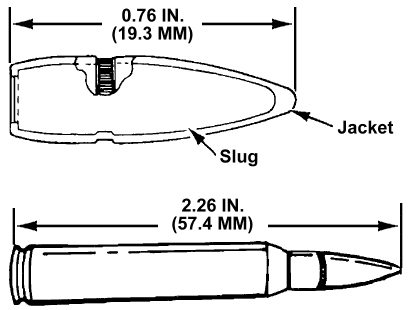
The cartridge is used by the M16 and M16A1 rifles. The cartridge is intended for use against personnel and unarmored
targets. This item is a training standard item used in both training and combat.
This cartridge can be fired by the M249 machine gun, but accuracy is degraded; therefore, it should only be used in emergency situations.
The M193 cartridge has a bullet with a copper alloy jacket and a lead antimony alloy core. The cartridge is
identified by a plain bullet tip.
Type Classification: STD - AMCTC 5143. Type Classification Date: 1975.
Unit cost: $0.24 (Fiscal Year 2005).
Cartridge, 5.56mm, Grenade, M195
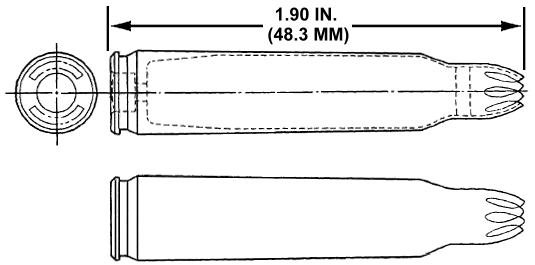
The cartridge is used by the M16 and M16A1 rifles. The cartridge provides pressure, on functioning, to
project grenades to a desired target using a grenade projection adapter.
The cartridge is identified by a rose-petal (rosette-crimp) closure of the cartridge case mouth sealed with red lacquer.
Type Classification: STD - AMCTC 6919
Cartridge, 5.56mm, Tracer, M196
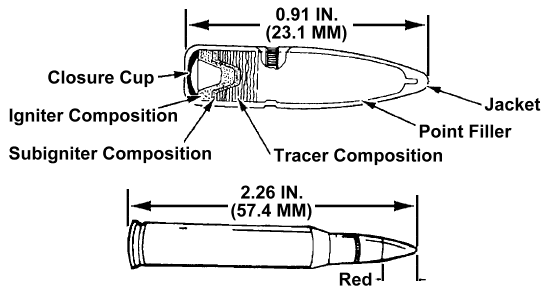
The cartridge is used by the M16 and M16A1 rifles. The tracer is intended to permit visible observation of
the bullet's in-flight path or trajectory to the point of impact. Its main uses are for observation
of fire, incendiary effect, and signaling.
This cartridge can be fired by the M249 machine gun, but accuracy is degraded; therefore, it should only be used in emergency situations.
R284 tracer. The cartridge is identified by a red bullet tip.
Type Classification: STD - AMCTC 5055
Cartridge, 5.56mm, High Presure Test, M197
The cartridge is used by the M16 and M16A1 rifles. The cartridge is used to proof test weapons during
manufacture, test, or repair. The cartridge is loaded with a special propellant to produce pressures substantially
in excess of the service round.
The cartridge is identified by a stannic-stained (silvered) or nickel-plated cartridge case.
Type Classification: STD - AMCTC 4484
Cartridge, 5.56mm, Dummy, M199
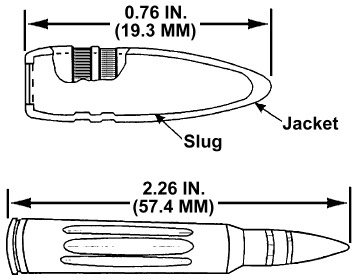
The cartridge is used by the M249 machine gun and M16/A1/A2/A3/A4 and M4-series weapons. The cartridge is used for
practice in loading 5.56mm weapons, for simulated firing to detect flinching of personnel when firing, and for
inspecting and testing the weapon mechanisms. This round contains no propellant.
The cartridge is identified by six longitudinal corrugations (flutings) in the cartridge case and by the absence of
a primer. The primer well is open to prevent damage to the firing pin.
d.
Type Classification: STD - AMCTC 4662
Cartridge, 5.56mm, Blank, M200
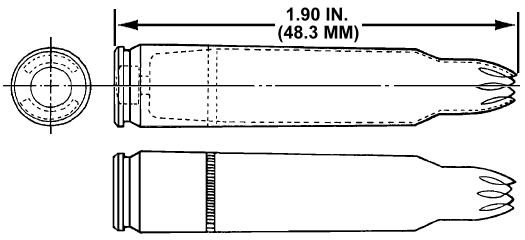
The cartridge is used by the M249 machine gun and all 5.56mm rifles (M16/A1/A2/A3/A4 and M4-series weapons).
A blank-firing attachment must be used to fire this ammunition. The cartridge is designed for simulated firing in
training exercises and for saluting purposes. The M200 blank cartridge has no projectile.
This is a training unique item; not used in combat.
The original M200 blank cartridge had a white tip. Field use of this cartridge resulted in residue buildup, which
caused malfunctions. Only the violet-tipped M200 cartridge should be used.
The cartridge is identified by a rose-petal (rosette-crimp) closure of the cartridge case mouth. An engraved knurl
is located 1/2 inch from the head of the cartridge case.
Type Classification: STD - AMCTC 5942. Type Classification Date: Prior to 1977.
Unit cost: $0.09 (Fiscal Year 2005).
Cartridge, 5.56mm, Dummy, M232
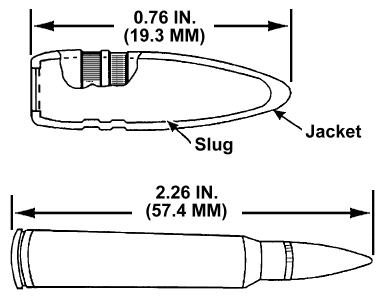
The cartridge is used by the M16 and M16A1 rifles. The cartridge is an inert round used for testing the mechanisms
of 5.56mm weapons.
The cartridge is identified by a black chemical finish over the entire round and by the absence of a primer.
Type Classification: STD - AMCTC 4485
Unit cost: $0.52 (Fiscal Year 2005).
Cartridge, 5.56mm, Blank, M755
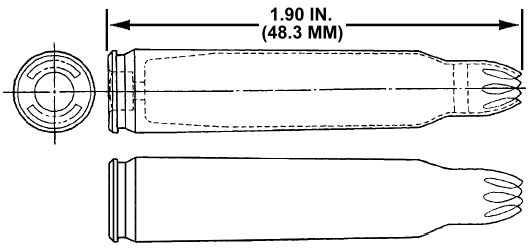
The M755 blank cartridge is especially designed for use with the Sting Ring Airfoil Munition System which
consists of the M234 launcher and the 64mm riot control M743 projectile fired from the M1GA1 rifle.
The cartridge is only for use with the M234 riot control 64mm projectile launcher. The launcher is attached to the
flash suppressor of the M16A1 rifle and actuated by firing an M755 5.56mm blank cartridge. The M755 blank cartridge
is the only cartridge that will give the projectile M743 the proper velocity. Use of other blank cartridges may
damage the system.
The blank cartridge is fed into the firing chamber. When fired, the primer ignites the propellant. The expanding
propellant, gases pass from the muzzle of the rifle into the launcher manifold. The projectile is ejected from the
launcher barrel to a maximum range of 328 feet (100 m). The propellant charge is not sufficient to eject the
cartridge case which must be ejected by pulling the charging handle of the rifle all the way back.
The cartridge is closed with a seven petal nose crimp and moisture sealed. The crimped tips of the cartridge is
painted with yellow lacquer for identification and thus lessen the chance of mixing them with the standard 5.56mm
blank cartridges.
Type Classification: STD - MSR 04786005
Cartridge, 5.56mm, Ball, M855
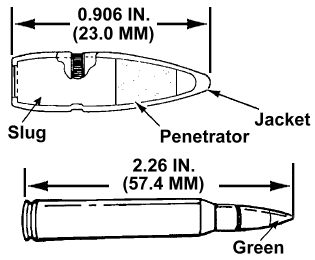
The cartridge is used by the M249 machine gun and the M16A2/A3/A4 and M4-series weapons. The cartridge is intended
for use against personnel and unarmored targets. This is a training standard item used in both training and combat.
The M855 cartridge has a 62-grain, gilded metal-jacketed, lead alloy core bullet with a steel penetrator. The primer
and case are waterproof.
This ammunition should not be used in the M16A1 except under emergency conditions, and only at targets less than 90
meters in distance. (The twist of the M16A1 rifling is not sufficient to stabilize the longer projectile of the round).
The cartridge is identified by a green bullet tip.
Type Classification: STD - MSR 05826003. Type Classification Date: 1982.
Unit cost: $0.26 (Fiscal Year 2005).
Cartridge, 5.56mm, Ball, M855, Lead Free
The M855 "lead free" ball cartridge has a bullet with a conical steel insert and a tungsten composite core
in a copper alloy jacket. The intended use is to maintain environmentally "clean" ranges.
The cartridge is identified by a green bullet tip.
Type Classification Date: 1982.
Unit cost: $0.38 (Fiscal Year 2005).
Cartridge, 5.56mm, Tracer, M856
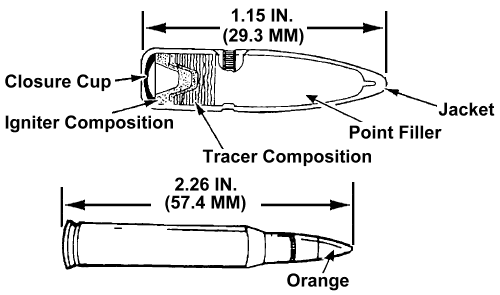
The cartridge is used by the M249 machine gun and the M16A2/A3/A4 and M4-series weapons. The tracer is intended to
permit visible observation of the bullet's in-flight path or trajectory to the point of impact. This is a training
standard item used in both training and combat.
The M856 tracer cartridge has characteristics similar to the M196 tracer with a slightly longer tracer burnout
distance. The M856 is ballistically matched to the M855 ball cartridge. The tracer bullet delivers a visible red
light signature through its trajectory. The M856 does not have a steel penetrator.
This ammunition should not be used in the M16A1 except under emergency conditions, and only at targets less than 90
meters in distance. (The twist of the M16A1 rifling is not sufficient to stabilize the projectile of the longer ammunition).
The cartridge is identified by an orange bullet tip.
Type Classification: STD - MSR 05826002. Type Classification Date: 1982.
Unit cost: $0.30 (Fiscal Year 2005).
Cartridge, 5.56mm, Plastic, Practice, M862
Cartridge, 5.56mm, Short-Range Training Ammunition (SRTA), M862

The cartridge is used by all rifles when equipped with the M2 training bolt. The cartridge is for training in local
and urban training areas where range restrictions preclude use of full range standard service ammunition.
Although M862 SRTA closely replicates the trajectory and characteristics of service ammunition out to 25 meters,
it should not be used to set battle sight zero of weapons to fire service ammunition. The settings that are placed
on the sights for SRTA could be different for service ammunition.
If adequate range facilities are not available for sustainment training, SRTA can be used for any firing exercise of
25 meters or less. This includes the 25-meter scaled silhouette, 25-meter alternate qualification course, and
quick-fire training. SRTA can also be used for Urban Operations training.
The cartridge is identified by a blue plastic bullet.
Unit cost: $0.61 (Fiscal Year 2005).
Cartridge, 5.56mm, Armor Piercing (AP), M995


The cartridge is used by the M249 machine gun and the M16A2/A3/A4 and M4-series weapons. Procurement is intended for
use against current and future light armored targets. The M995 offers the capability to defeat these targets at
ranges 2 to 3 times that of currently available 5.56mm ammunition.
The cartridge consists of a projectile and a propelling charge contained in a brass cartridge case to which the
projectile is secured. The projectile consists of a dense metal penetrator (tungsten carbide), which is enclosed by
a standard gilding metal jacket. An aluminum cup sits at the rear of the projectile for the purpose of properly
locating the penetrator within the projectile. The cartridge utilizes a conventional brass case and double base
propellant. A standard rifle cartridge primer is used in the case to initiate the propelling charge.
The penetrator is similar to components used in other small caliber cartridges currently used by the US Army, but
tungsten has better penetration capabilities than the other materials and is the design feature, which enhances the
armor piercing capability of the cartridge.
This cartridge is identified by black bullet tip identification paint.
Type Classification: Std - 29 Mar 96
Unit cost: $1.44 (Fiscal Year 2005).
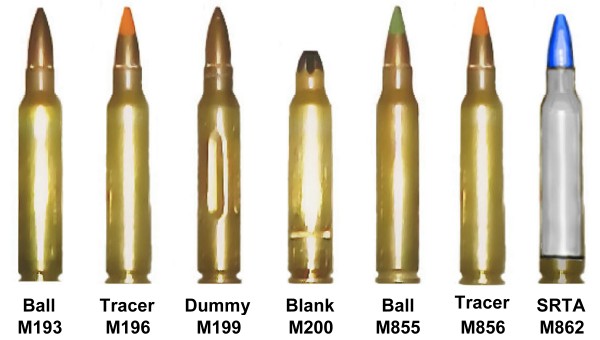

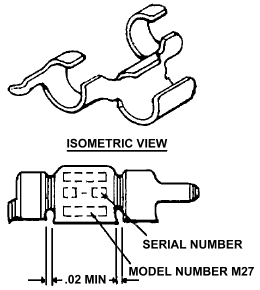



 The cartridge is used by the M16 and M16A1 rifles. The cartridge is intended for use against personnel and unarmored
targets. This item is a training standard item used in both training and combat.
The cartridge is used by the M16 and M16A1 rifles. The cartridge is intended for use against personnel and unarmored
targets. This item is a training standard item used in both training and combat.
 The cartridge is used by the M16 and M16A1 rifles. The cartridge provides pressure, on functioning, to
project grenades to a desired target using a grenade projection adapter.
The cartridge is used by the M16 and M16A1 rifles. The cartridge provides pressure, on functioning, to
project grenades to a desired target using a grenade projection adapter.
 The cartridge is used by the M16 and M16A1 rifles. The tracer is intended to permit visible observation of
the bullet's in-flight path or trajectory to the point of impact. Its main uses are for observation
of fire, incendiary effect, and signaling.
The cartridge is used by the M16 and M16A1 rifles. The tracer is intended to permit visible observation of
the bullet's in-flight path or trajectory to the point of impact. Its main uses are for observation
of fire, incendiary effect, and signaling.
 The cartridge is used by the M249 machine gun and M16/A1/A2/A3/A4 and M4-series weapons. The cartridge is used for
practice in loading 5.56mm weapons, for simulated firing to detect flinching of personnel when firing, and for
inspecting and testing the weapon mechanisms. This round contains no propellant.
The cartridge is used by the M249 machine gun and M16/A1/A2/A3/A4 and M4-series weapons. The cartridge is used for
practice in loading 5.56mm weapons, for simulated firing to detect flinching of personnel when firing, and for
inspecting and testing the weapon mechanisms. This round contains no propellant.
 The cartridge is used by the M249 machine gun and all 5.56mm rifles (M16/A1/A2/A3/A4 and M4-series weapons).
A blank-firing attachment must be used to fire this ammunition. The cartridge is designed for simulated firing in
training exercises and for saluting purposes. The M200 blank cartridge has no projectile.
This is a training unique item; not used in combat.
The cartridge is used by the M249 machine gun and all 5.56mm rifles (M16/A1/A2/A3/A4 and M4-series weapons).
A blank-firing attachment must be used to fire this ammunition. The cartridge is designed for simulated firing in
training exercises and for saluting purposes. The M200 blank cartridge has no projectile.
This is a training unique item; not used in combat.
 The cartridge is used by the M16 and M16A1 rifles. The cartridge is an inert round used for testing the mechanisms
of 5.56mm weapons.
The cartridge is used by the M16 and M16A1 rifles. The cartridge is an inert round used for testing the mechanisms
of 5.56mm weapons.
 The M755 blank cartridge is especially designed for use with the Sting Ring Airfoil Munition System which
consists of the M234 launcher and the 64mm riot control M743 projectile fired from the M1GA1 rifle.
The M755 blank cartridge is especially designed for use with the Sting Ring Airfoil Munition System which
consists of the M234 launcher and the 64mm riot control M743 projectile fired from the M1GA1 rifle.
 The cartridge is used by the M249 machine gun and the M16A2/A3/A4 and M4-series weapons. The cartridge is intended
for use against personnel and unarmored targets. This is a training standard item used in both training and combat.
The cartridge is used by the M249 machine gun and the M16A2/A3/A4 and M4-series weapons. The cartridge is intended
for use against personnel and unarmored targets. This is a training standard item used in both training and combat.
 The cartridge is used by the M249 machine gun and the M16A2/A3/A4 and M4-series weapons. The tracer is intended to
permit visible observation of the bullet's in-flight path or trajectory to the point of impact. This is a training
standard item used in both training and combat.
The cartridge is used by the M249 machine gun and the M16A2/A3/A4 and M4-series weapons. The tracer is intended to
permit visible observation of the bullet's in-flight path or trajectory to the point of impact. This is a training
standard item used in both training and combat.
 The cartridge is used by all rifles when equipped with the M2 training bolt. The cartridge is for training in local
and urban training areas where range restrictions preclude use of full range standard service ammunition.
The cartridge is used by all rifles when equipped with the M2 training bolt. The cartridge is for training in local
and urban training areas where range restrictions preclude use of full range standard service ammunition.

 The cartridge is used by the M249 machine gun and the M16A2/A3/A4 and M4-series weapons. Procurement is intended for
use against current and future light armored targets. The M995 offers the capability to defeat these targets at
ranges 2 to 3 times that of currently available 5.56mm ammunition.
The cartridge is used by the M249 machine gun and the M16A2/A3/A4 and M4-series weapons. Procurement is intended for
use against current and future light armored targets. The M995 offers the capability to defeat these targets at
ranges 2 to 3 times that of currently available 5.56mm ammunition.